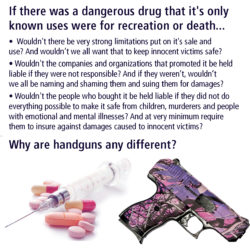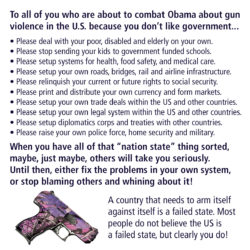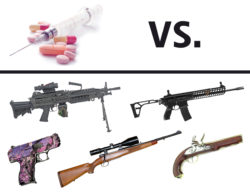 I posted some things similar to this post a few months ago about drugs and guns and the lack of some people to want the government to control anything. Since that time, and many blood baths later, exactly ZERO progress has been made, so I want to expand on this more and try to remove the emotional response that it evokes where it often comes down to semantics and ignoring other laws designed to have a similar outcome.
I posted some things similar to this post a few months ago about drugs and guns and the lack of some people to want the government to control anything. Since that time, and many blood baths later, exactly ZERO progress has been made, so I want to expand on this more and try to remove the emotional response that it evokes where it often comes down to semantics and ignoring other laws designed to have a similar outcome.
I’m also including information for people from other countries, who just cannot fathom what the big problem is in the U.S. for not adopting “sensible gun control” laws.
For the purpose of protecting citizens from controlled substances, I think most people will agree that legal interventions can control availability, lessen consumption and reduce the harm associated with the use and abuse of drugs. If the same logic were to be applied to firearms, it very well could have the same results, e.g., to control availability, lessen violence and reduce the harm associated with use and abuse of firearms. As with drugs, this does not mean that the “bad guys” won’t have access to them, but it would probably have an impact, along with an impact on the many other deaths caused by firearms that are supposedly in the hands of the “good guys”. With a few exceptions like marijuana, alcohol and tobacco, I don’t think many really believe that heroin should not be controlled. My question is, why should firearms be any different?
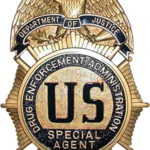 As an overview of the laws, the Controlled Substances Act (CSA) and the Comprehensive Drug Abuse Prevention and Control Act are the federal U.S. laws regulating the manufacture, importation, possession, use and distribution of controlled substances “drugs” in the United States and under international treaties. The enforcement authority is the Drug Enforcement Administration (DEA). As far as I am aware, there are no state or local laws that override the federal laws, with the exception of marijuana, which has not yet been hashed out. In other words, you can’t just drive to the next state or order online if you want to buy heroin legally.
As an overview of the laws, the Controlled Substances Act (CSA) and the Comprehensive Drug Abuse Prevention and Control Act are the federal U.S. laws regulating the manufacture, importation, possession, use and distribution of controlled substances “drugs” in the United States and under international treaties. The enforcement authority is the Drug Enforcement Administration (DEA). As far as I am aware, there are no state or local laws that override the federal laws, with the exception of marijuana, which has not yet been hashed out. In other words, you can’t just drive to the next state or order online if you want to buy heroin legally.
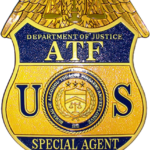 The National Firearms Act (NFA) and the Gun Control Act (GCA) and other laws, including the now defunct Assault Weapons Ban (AWB), are the equivalent federal laws regulating weapons and firearms in the U.S. The enforcement authority for both NFA and GCA is the Bureau of Alcohol, Tobacco, Firearms and Explosives (ATF). As far as I am aware, there are many state and local laws that override the federal laws, and it makes for a confusing mess for both citizens and other countries trying to stem the flow of firearms into their own countries. In other words, you can easily drive to the next state, or sometimes even the next city, or order online if you want to buy a semi-automatic rifle like the AR-15 legally.
The National Firearms Act (NFA) and the Gun Control Act (GCA) and other laws, including the now defunct Assault Weapons Ban (AWB), are the equivalent federal laws regulating weapons and firearms in the U.S. The enforcement authority for both NFA and GCA is the Bureau of Alcohol, Tobacco, Firearms and Explosives (ATF). As far as I am aware, there are many state and local laws that override the federal laws, and it makes for a confusing mess for both citizens and other countries trying to stem the flow of firearms into their own countries. In other words, you can easily drive to the next state, or sometimes even the next city, or order online if you want to buy a semi-automatic rifle like the AR-15 legally.
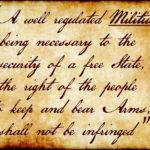 For a historical perspective, the gun control controversy began with the very dated wording of the 2nd Amendment, which is part of the first ten amendments to the US Constitution contained in the Bill of Rights adopted in 1791. It reads “A well regulated Militia, being necessary to the security of a free State, the right of the people to keep and bear Arms, shall not be infringed”. As one would expect, there have been many amendments to the constitution, 33 in total, which were made to fit the times and circumstances, as the original “living” Constitution had intended. But for some reason this particular amendment seems to be stuck in the past, even though it really only mentions “Arms” [firearms] meant for “Militia” [military] use as was logical in a time when the U.S. had a relatively small standing army and relied on the state militia system who could be recruited during wartime.
For a historical perspective, the gun control controversy began with the very dated wording of the 2nd Amendment, which is part of the first ten amendments to the US Constitution contained in the Bill of Rights adopted in 1791. It reads “A well regulated Militia, being necessary to the security of a free State, the right of the people to keep and bear Arms, shall not be infringed”. As one would expect, there have been many amendments to the constitution, 33 in total, which were made to fit the times and circumstances, as the original “living” Constitution had intended. But for some reason this particular amendment seems to be stuck in the past, even though it really only mentions “Arms” [firearms] meant for “Militia” [military] use as was logical in a time when the U.S. had a relatively small standing army and relied on the state militia system who could be recruited during wartime.
In the 1930s, the U.S. had a lot-of very publicized gangster violence — think Dillinger, Al Capone, Bonnie and Clyde, etc, much like today with mass shootings. Rather than ban harmful weapons that had few safe uses, which would have required amending the 2nd Amendment of the Constitution, most harmful weapons were heavily taxed and a registration system to control their transfer was started. The NFA did not create much controversy at that time, unlike gun-control today, because most of the public had had enough of the violence and groups like the National Rifle Association (NRA) did not have much power.
The categories of firearms regulated under the NFA have changed over time, and so have the restrictions put on them. In many respects, most military style firearms are so restricted that it is already a de facto ban ffor individuals to own them. If people want the right to bear military style firearms, they need to join the military or the Guard and Reserves, but they still won’t be able to take their military style firearms home, as is done in some countries like Switzerland.
When it came to an individuals a right to “bear arms”, the courts had already ruled that the “militia clause,” trumped the second part, the “bear arms” clause. In other words, the amendment allowed state militias a right to bear arms—but did not give individuals a right to own or carry a weapon. In the 1970s the NRA pushed for a re-interpretation of the 2nd Amendment, one that gave individuals, not just militias, the right to bear arms, and hence the controversy that exists today. What resulted was a rather odd court decision that the government cannot ban handguns, but it also did not allow for individual right to military style firearms or other types of firearms that were not handguns. In other words, the door was left open to ban other firearms that are deemed to be too unsafe, for example assault style and semi-automatic firearms.
 Even if this was not the case, using the 2nd Amendment as a catch-all for any “sensible gun control” would be the equivalent comparison if “medicaments” [medications], like mercury purgatives to induce vomiting blood, were enshrined in the first ten amendments. Interestingly enough, one of the signers to the U.S. Declaration of Independence named Benjamin Rush was a staunch supporter of mercury purgatives and bloodletting, but thankfully it never got enshrined in the first ten amendments to the constitution! Regardless, the laws need to reflect the relative harm of what modern weapons cause, compared to an18th-century musket.
Even if this was not the case, using the 2nd Amendment as a catch-all for any “sensible gun control” would be the equivalent comparison if “medicaments” [medications], like mercury purgatives to induce vomiting blood, were enshrined in the first ten amendments. Interestingly enough, one of the signers to the U.S. Declaration of Independence named Benjamin Rush was a staunch supporter of mercury purgatives and bloodletting, but thankfully it never got enshrined in the first ten amendments to the constitution! Regardless, the laws need to reflect the relative harm of what modern weapons cause, compared to an18th-century musket.
 By way of example, I think it would be completely possible the classify firearms in a way similar to how controlled substances are classified. Controlled substances are divided into five schedules (or classes) on the basis of their potential for abuse, accepted scientific or medical use, and accepted safety under medical supervision. Substances in Schedule I have a high potential for abuse, no accredited medical use, and a lack of accepted safety. From Schedules II to V, the substances have a currently accepted medical use, with a decrease in potential for abuse.
By way of example, I think it would be completely possible the classify firearms in a way similar to how controlled substances are classified. Controlled substances are divided into five schedules (or classes) on the basis of their potential for abuse, accepted scientific or medical use, and accepted safety under medical supervision. Substances in Schedule I have a high potential for abuse, no accredited medical use, and a lack of accepted safety. From Schedules II to V, the substances have a currently accepted medical use, with a decrease in potential for abuse.
In contrast, the firearms classifications are generally referred to as Title II for the NFA and Title I for the GCA, but there is very little distinction made based on their accepted use or evidence-based accepted safety in relation to potential for violence and harm caused, both physically and psychologically. In the examples I use the term “recreation” to include sport shooting and other activities that are done primarily for fun that need to be weighed against their potential to harm.
Schedule I controlled substances are drugs like Heroin, LSD, MDMA “ecstasy”, date rape drugs, etc. That means that they have a high potential for abuse, have no currently accepted use and there is a lack of accepted safety for use even under supervision. This also includes naturally-occurring drugs like marijuana, mescaline, peyote and psilocybin mushrooms, which other than for some medical and religious purposes are not legal.
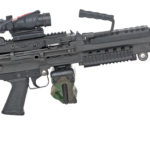 Schedule I controlled substances are analogous to weapons and firearms that are regulated by Title II under the NFA, including machine guns, short-barrelled shotguns/rifles, destructive devices (e.g., bombs, grenades, rockets, missiles, mines and similar devices), silencers and any other weapon (AOW) as defined as “any weapon or device capable of being concealed on the person from which a shot can be discharged through the energy of an explosive,” other than a handgun with a rifled barrel. As far as I am aware, most people do not disagree with this level of gun control, but a notable exception was when a gun instructor was shot and killed by a nine-year-old kid he had been teaching to shoot an Uzi, which was possible due to loopholes in the laws, and odder yet that the shooting was viewed as an “industrial accident”.
Schedule I controlled substances are analogous to weapons and firearms that are regulated by Title II under the NFA, including machine guns, short-barrelled shotguns/rifles, destructive devices (e.g., bombs, grenades, rockets, missiles, mines and similar devices), silencers and any other weapon (AOW) as defined as “any weapon or device capable of being concealed on the person from which a shot can be discharged through the energy of an explosive,” other than a handgun with a rifled barrel. As far as I am aware, most people do not disagree with this level of gun control, but a notable exception was when a gun instructor was shot and killed by a nine-year-old kid he had been teaching to shoot an Uzi, which was possible due to loopholes in the laws, and odder yet that the shooting was viewed as an “industrial accident”.
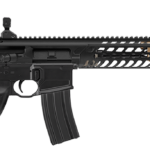 Where it seems to get tricky for some people to grasp is where schedule I controlled substances are also analogous to firearms that are regulated by Title I under the GCA, including semi-automatic rifles, shotguns, pistols and handguns, with a large magazine of ammunition configured for rapid fire and combat style use. That comparison means that they have a high potential for violence, have no currently accepted use and there is a lack of accepted safety for use even under supervision. In other words, the only use for these weapons other than military and law enforcement is recreational use and mass murder. I do not include hunting in this category, because it is questionable if using semi-automatic firearms is really hunting, with a few exceptions, like for people who are disabled. When compared to the harm that they inflict, it would be much better for people to acquire reasonable hunting and shooting skills with a more appropriate and less harmful firearm.
Where it seems to get tricky for some people to grasp is where schedule I controlled substances are also analogous to firearms that are regulated by Title I under the GCA, including semi-automatic rifles, shotguns, pistols and handguns, with a large magazine of ammunition configured for rapid fire and combat style use. That comparison means that they have a high potential for violence, have no currently accepted use and there is a lack of accepted safety for use even under supervision. In other words, the only use for these weapons other than military and law enforcement is recreational use and mass murder. I do not include hunting in this category, because it is questionable if using semi-automatic firearms is really hunting, with a few exceptions, like for people who are disabled. When compared to the harm that they inflict, it would be much better for people to acquire reasonable hunting and shooting skills with a more appropriate and less harmful firearm.
Schedule II controlled substance are drugs like fentanyl, morphine, cocaine, methamphetamines and many pain relieving opioids, anaesthetics and sedatives. That means that they have a high potential for abuse, but have currently accepted use with severe restrictions and abuse may lead to severe psychological or physical problems.
 Schedule II controlled substances are analogous to handguns with a rifled barrel that are regulated by Title I under the GCA. That comparison means that they have a high potential for violence, but have currently accepted use with severe restrictions and abuse may lead to severe psychological or physical problems. In other words, there is a use for these weapons other than military and law enforcement, e.g., personal defense and recreational use, but they require severe restrictions.
Schedule II controlled substances are analogous to handguns with a rifled barrel that are regulated by Title I under the GCA. That comparison means that they have a high potential for violence, but have currently accepted use with severe restrictions and abuse may lead to severe psychological or physical problems. In other words, there is a use for these weapons other than military and law enforcement, e.g., personal defense and recreational use, but they require severe restrictions.
Schedule III controlled substances include many barbiturates, steroids, pain relievers, stimulants and sedatives. That means that they have a potential for abuse, but have currently accepted use and abuse may lead to moderate physical or high psychological problems.
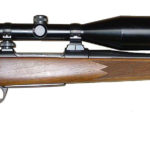 Schedule III controlled substances are analogous traditional rifles and shotguns that are regulated by Title I under the GCA. That comparison means that they have a potential for violence, but have currently accepted use and abuse may lead to moderate physical or psychological problems. In other words, there is a use for these weapons, e.g., personal defense, hunting and recreational use, but they require some restrictions. As far as I am aware, when talking about “sensible gun control“, very few people are looking to change the laws about these firearms.
Schedule III controlled substances are analogous traditional rifles and shotguns that are regulated by Title I under the GCA. That comparison means that they have a potential for violence, but have currently accepted use and abuse may lead to moderate physical or psychological problems. In other words, there is a use for these weapons, e.g., personal defense, hunting and recreational use, but they require some restrictions. As far as I am aware, when talking about “sensible gun control“, very few people are looking to change the laws about these firearms.
 Schedule IV-V controlled substances are analogous to the rest of the firearms that are regulated by Title I under the GCA, e.g., mostly antique firearms. That comparison means that they have a potential for violence, but have currently accepted use and abuse may lead to only limited physical or psychological problems. Again, as far as I am aware, when talking about “sensible gun control“, very few people are looking to change the laws about these firearms kept for historical, folkloric or decorative value.
Schedule IV-V controlled substances are analogous to the rest of the firearms that are regulated by Title I under the GCA, e.g., mostly antique firearms. That comparison means that they have a potential for violence, but have currently accepted use and abuse may lead to only limited physical or psychological problems. Again, as far as I am aware, when talking about “sensible gun control“, very few people are looking to change the laws about these firearms kept for historical, folkloric or decorative value.
Really, both systems need to be completely re-worked in an evidence-based way. For controlled substances the classification system should include alcohol and tobacco, while some others are all less harmful and should probably have a lower classification and cannabis even lower or not at all. The hypocrisy in the current situation is that there are many people suffering needlessly pain due to chronic health conditions for lack of being able to use controlled substances, some as mild as marijuana. Meanwhile, other substances like alcohol and tobacco inflict a huge toll. At least for alcohol people are usually held responsible for the harm they inflict on others by way of drunk driving laws and other compensatory methods through the courts and for tobacco there are higher health insurance premiums and the ongoing cost of taxes. By not scheduling these drugs properly the U.S. has one of the highest incarceration rates in the world for non-violent drug offenses with a huge expense to the taxpayer, and accomplishing almost nothing for the safety or well-being of other citizens.
Re-working gun control needs to begin with allowing the Centers for Disease Control (CDC) to study gun violence and it’s implications, and then classifying firearms appropriately based on the harm they cause relative to their intended application of good use. For firearms there is almost no accountability for harm done in many U.S. states, unless it is used while committing a crime. Oftentimes, there is also very little redress because of inadequate training, unsecure gun storage, lack of parental supervision, reckless handling, accidental discharge and negligence by manufacturer’s or sellers’ in not providing adequate safety measures. These situations would never be allowed when it comes to controlled substances, or practically any other product on the market for that matter. As a side note, it would probably make sense for controlled substances that are handled by the AFT, e.g., alcohol and tobacco, to be enforced under the DEA, and leave the AFT to focus on the illegal use and trafficking of firearms, illegal use and storage of explosives, acts of arson and bombings, acts of terrorism, etc.
 Like many people, I found it very sad when the dog Bubba was recently found on heroin and methamphetamine. Rightfully, his owner was arrested and will face charges for animal cruelty. What I can’t understand is all of the so called “tragedies and accidents” that I read about on a daily basis about situations with guns that cause harm. Wouldn’t it also be right that any gun owner who’s firearm causes harm to others for any of the things mentioned above was also faced charges? At very minimum, manufacturer’s, sellers’ and people who own firearms should be required to purchase liability insurance based on the potential for harm, for both bodily injury and damages, just as is required to operate a vehicle.
Like many people, I found it very sad when the dog Bubba was recently found on heroin and methamphetamine. Rightfully, his owner was arrested and will face charges for animal cruelty. What I can’t understand is all of the so called “tragedies and accidents” that I read about on a daily basis about situations with guns that cause harm. Wouldn’t it also be right that any gun owner who’s firearm causes harm to others for any of the things mentioned above was also faced charges? At very minimum, manufacturer’s, sellers’ and people who own firearms should be required to purchase liability insurance based on the potential for harm, for both bodily injury and damages, just as is required to operate a vehicle.
Note: Here are some of the other posts I made after recent mass shootings for reference:
